Improved Feedback Quantizer with Discrete Space Vector
Abstract
1. Introduction
2. Feedback Quantizer
3. Proposal for a Feedback Quantizer with a Discrete Space Vector
4. Experimental Results
5. Advantages and Disadvantages of the Proposed Scheme
6. Conclusions
Author Contributions
Funding
Institutional Review Board Statement
Informed Consent Statement
Data Availability Statement
Acknowledgments
Conflicts of Interest
References
- Akagi, H. Multilevel Converters: Fundamental Circuits and Systems. Proc. IEEE 2017, 105, 2048–2065. [Google Scholar] [CrossRef]
- Joseph, A.; Chelliah, T.R. A Review of Power Electronic Converters for Variable Speed Pumped Storage Plants: Configurations, Operational Challenges, and Future Scopes. IEEE J. Emerg. Sel. Top. Power Electron. 2018, 6, 103–119. [Google Scholar] [CrossRef]
- Poorfakhraei, A.; Narimani, M.; Emadi, A. A Review of Multilevel Inverter Topologies in Electric Vehicles: Current Status and Future Trends. IEEE Open J. Power Electron. 2021, 2, 155–170. [Google Scholar] [CrossRef]
- Pérez, R.; Rivera, M.; Salgueiro, Y.; Baier, C.R.; Wheeler, P. Moving Microgrid Hierarchical Control to an SDN-Based Kubernetes Cluster: A Framework for Reliable and Flexible Energy Distribution. Sensors 2023, 23, 3395. [Google Scholar] [CrossRef] [PubMed]
- Rohten, J.; Villarroel, F.; Silva, J.; Pulido, E.; Pierart, F.; Guzmán, J.; García-Santander, L. Power Converter Resonant Control for an Unbalanced and Non-Constant Frequency Supply. Sensors 2023, 23, 4884. [Google Scholar] [CrossRef]
- Mönch, S.; Reiner, R.; Basler, M.; Grieshaber, D.; Benkhelifa, F.; Waltereit, P.; Quay, R. Three-Phase Motor Inverter and Current Sensing GaN Power IC. Sensors 2023, 23, 6512. [Google Scholar] [CrossRef]
- Ibrahim, N.F.; Alkuhayli, A.; Beroual, A.; Khaled, U.; Mahmoud, M.M. Enhancing the Functionality of a Grid-Connected Photovoltaic System in a Distant Egyptian Region Using an Optimized Dynamic Voltage Restorer: Application of Artificial Rabbits Optimization. Sensors 2023, 23, 7146. [Google Scholar] [CrossRef]
- Ahmed, H.O.A.; Yu, Y.; Wang, Q.; Darwish, M.; Nandi, A.K. Intelligent Fault Diagnosis Framework for Modular Multilevel Converters in HVDC Transmission. Sensors 2022, 22, 362. [Google Scholar] [CrossRef] [PubMed]
- Nakutis, Ž.; Lukočius, R.; Girdenis, V.; Kroičs, K. A Measurement Method of Power Transferred to an Electric Vehicle Using Wireless Charging. Sensors 2023, 23, 9636. [Google Scholar] [CrossRef]
- Sharaf, M.A.; Armghan, H.; Ali, N.; Yousef, A.; Abdalla, Y.S.; Boudabbous, A.R.; Mehdi, H.; Armghan, A. Hybrid Control of the DC Microgrid Using Deep Neural Networks and Global Terminal Sliding Mode Control with the Exponential Reaching Law. Sensors 2023, 23, 9342. [Google Scholar] [CrossRef]
- Leon, J.I.; Kouro, S.; Franquelo, L.G.; Rodriguez, J.; Wu, B. The Essential Role and the Continuous Evolution of Modulation Techniques for Voltage-Source Inverters in the Past, Present, and Future Power Electronics. IEEE Trans. Ind. Electron. 2016, 63, 2688–2701. [Google Scholar] [CrossRef]
- Poorfakhraei, A.; Narimani, M.; Emadi, A. A Review of Modulation and Control Techniques for Multilevel Inverters in Traction Applications. IEEE Access 2021, 9, 24187–24204. [Google Scholar] [CrossRef]
- Funato, H.; Sasaki, C.; Chiku, Y.; Ogasawara, S. Analysis of loss of receiving transformer caused by harmonic current and voltage for loss reduction. In Proceedings of the 14th International Power Electronics and Motion Control Conference EPE-PEMC 2010, Ohrid, Macedonia, 6–8 September 2010. [Google Scholar]
- Grebović, S.; Oprašić, N.; Fejzić, A.; Kartal, H.; Akšamović, A.; Konjicija, S. A Low Cost Real-Time Transient Recorder for High Voltage Systems. Sensors 2023, 23, 9769. [Google Scholar] [CrossRef]
- Mirzaeva, G.; Goodwin, G. Introducing Feedback Quantizer—A Novel Pulse-Width Modulation Strategy for Voltage Source Inverters. In Proceedings of the 2012 22nd Australasian Universities Power Engineering Conference (AUPEC), Bali, Indonesia, 26–29 September 2012. [Google Scholar]
- Mirzaeva, G.; Goodwin, G. The use of Feedback Quantizer PWM for shaping inverter noise spectrum. In Proceedings of the 2012 15th International Power Electronics and Motion Control Conference (EPE/PEMC), Novi Sad, Serbia, 4–6 September 2012. [Google Scholar]
- Mirzaeva, G.; Goodwin, G.; Diaz, M.; Silva, C. Noise shaping modulation and dynamic current control of NPC inverters for low switching frequency applications. In Proceedings of the 2013 IEEE Energy Conversion Congress and Exposition, Denver, CO, USA, 15–19 September 2013. [Google Scholar] [CrossRef]
- Mirzaeva, G.; Goodwin, G. Advanced noise shaping and filter design with Feedback Quantizer PWM. In Proceedings of the 2013 IEEE International Conference on Industrial Technology (ICIT), Cape Town, South Africa, 25–28 February 2013. [Google Scholar] [CrossRef]
- Veillon, M. Feedback Quantizer and Non Linear Control Applied to Multi-Cell AFE Rectifier. In Proceedings of the 2021 IEEE CHILEAN Conference on Electrical, Electronics Engineering, Information and Communication Technologies (CHILECON), Valparaíso, Chile, 6–9 December 2021. [Google Scholar] [CrossRef]
- Forrest, J.A.C.; Allard, B. Thermal problems caused by harmonic frequency leakage fluxes in three-phase, three-winding converter transformers. IEEE Trans. Power Deliv. 2004, 19, 208–213. [Google Scholar] [CrossRef]
- Mohammed, O.A.; Abed, N.Y.; Liu, S. Investigation of the harmonic behavior of three phase transformer under nonsinusoidal operation using finite element and wavelet packets. IEEE Trans. Magn. 2006, 42, 967–970. [Google Scholar] [CrossRef]
- Smajic, J.; Hughes, J.; Steinmetz, T.; Pusch, D.; Monig, W.; Carlen, M. Numerical Computation of Ohmic and Eddy-Current Winding Losses of Converter Transformers Including Higher Harmonics of Load Current. IEEE Trans. Magn. 2012, 48, 827–830. [Google Scholar] [CrossRef]
- Rodriguez, J.; Kazmierkowski, M.P.; Espinoza, J.R.; Zanchetta, P.; Abu-Rub, H.; Young, H.A.; Rojas, C.A. State of the Art of Finite Control Set Model Predictive Control in Power Electronics. IEEE Trans. Ind. Inform. 2013, 9, 1003–1016. [Google Scholar] [CrossRef]
- Ramírez, R.O.; Espinoza, J.R.; Melin, P.E.; Reyes, M.E.; Espinosa, E.E.; Silva, C.; Maurelia, E. Predictive Controller for a Three-Phase/Single-Phase Voltage Source Converter Cell. IEEE Trans. Ind. Inform. 2014, 10, 1878–1889. [Google Scholar] [CrossRef]
- Gada, S.; Fekik, A.; Mahdal, M.; Vaidyanathan, S.; Maidi, A.; Bouhedda, A. Improving Power Quality in Grid-Connected Photovoltaic Systems: A Comparative Analysis of Model Predictive Control in Three-Level and Two-Level Inverters. Sensors 2023, 23, 7901. [Google Scholar] [CrossRef]
- Li, P.; Tong, X.; Wang, Z.; Xu, M.; Zhu, J. Sensorless Model Predictive Control of Single-Phase Inverter for UPS Applications via Accurate Load Current Estimation. Sensors 2023, 23, 3742. [Google Scholar] [CrossRef]
- Veillon, M.; Espinosa, E.; Lizana, R.; Melin, P.; Mirzaeva, G.; Rivera, M.; Sepulveda, N. Alternative Feedback Quantizer Using Space Vector Modulation. In Proceedings of the 2023 IEEE International Conference on Industrial Technology (ICIT), Orlando, FL, USA, 4–6 April 2023; pp. 1–6. [Google Scholar] [CrossRef]
- Vazquez, S. Model Predictive Control with constant switching frequency using a Discrete Space Vector Modulation with virtual state vectors. In Proceedings of the 2009 IEEE International Conference on Industrial Technology, Churchill, VIC, Australia, 10–13 February 2009. [Google Scholar] [CrossRef]
- Alam, K.S.; Akter, M.P.; Xiao, D.; Zhang, D.; Rahman, M.F. Asymptotically Stable Predictive Control of Grid-Connected Converter Based on Discrete Space Vector Modulation. IEEE Trans. Ind. Inform. 2019, 15, 2775–2785. [Google Scholar] [CrossRef]
- Casadei, D.; Serra, G.; Tani, A. Improvement of direct torque control performance by using a discrete SVM technique. In Proceedings of the PESC 98 Record. 29th Annual IEEE Power Electronics Specialists Conference, Fukuoka, Japan, 22 May 1998. [Google Scholar]
- Casadei, D.; Serra, G.; Tani, A. Implementation of a direct control algorithm for induction motors based on discrete space vector modulation. IEEE Trans. Power Electron. 2000, 15, 769–777. [Google Scholar] [CrossRef]
- Yu, H.; Wang, J.; Xin, Z. Model Predictive Control for PMSM Based on Discrete Space Vector Modulation with RLS Parameter Identification. Energies 2022, 15, 4041. [Google Scholar] [CrossRef]
- Mohd Alsofyani, I.; Lee, K.-B. Predictive Torque Control Based on Discrete Space Vector Modulation of PMSM without Flux Error-Sign and Voltage-Vector Lookup Table. Electronics 2020, 9, 1542. [Google Scholar] [CrossRef]
- Beltran, J.P.M.; Hernandez, O.S.; Caporal, R.M.; Ordaz-Oliver, P.; Cuvas-Castillo, C. Model Predictive Torque Control of an Induction Motor with Discrete Space Vector Modulation. In Proceedings of the 2020 17th International Conference on Electrical Engineering, Computing Science and Automatic Control (CCE), Mexico City, Mexico, 11–13 November 2020; pp. 1–6. [Google Scholar] [CrossRef]
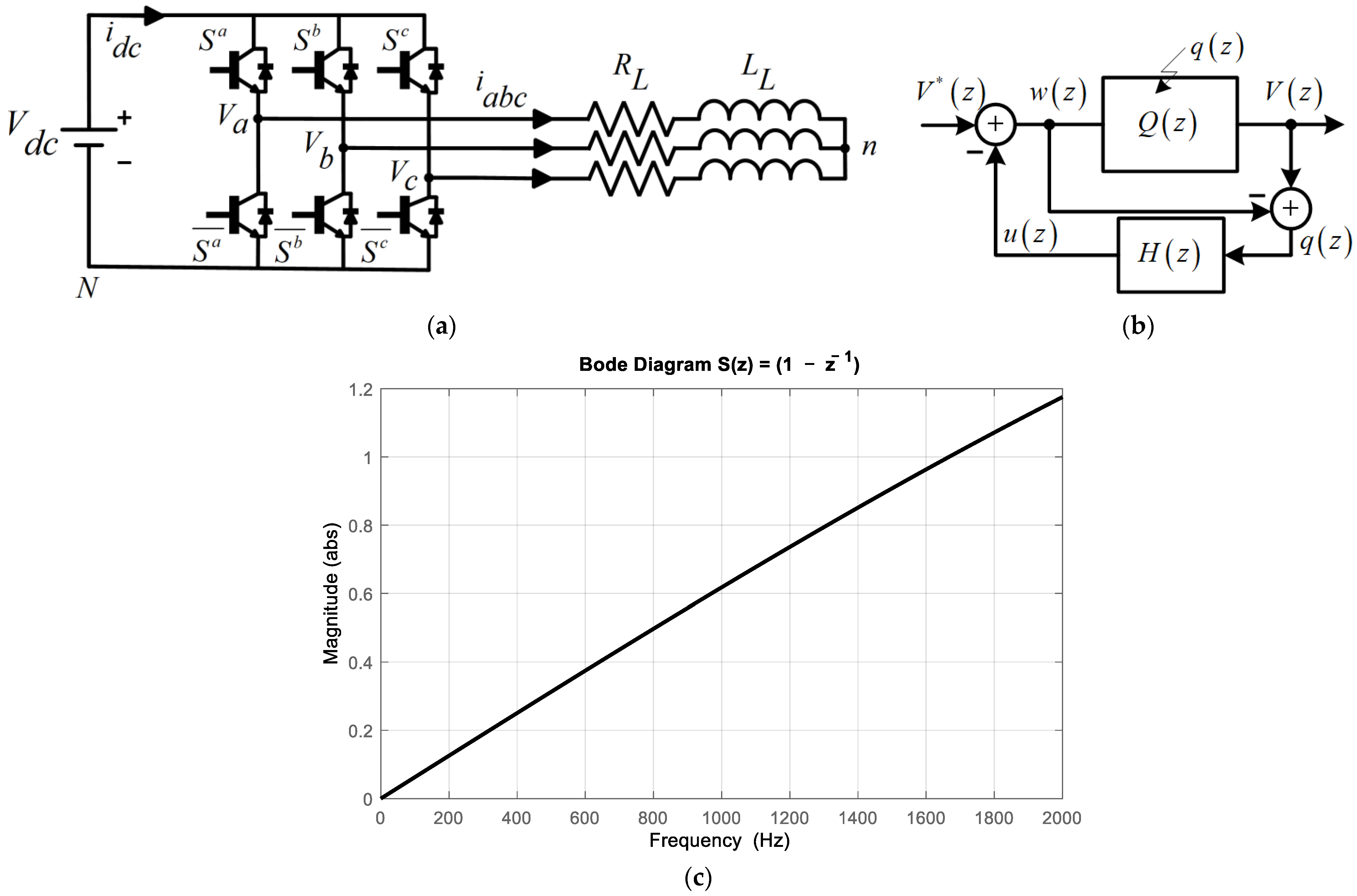
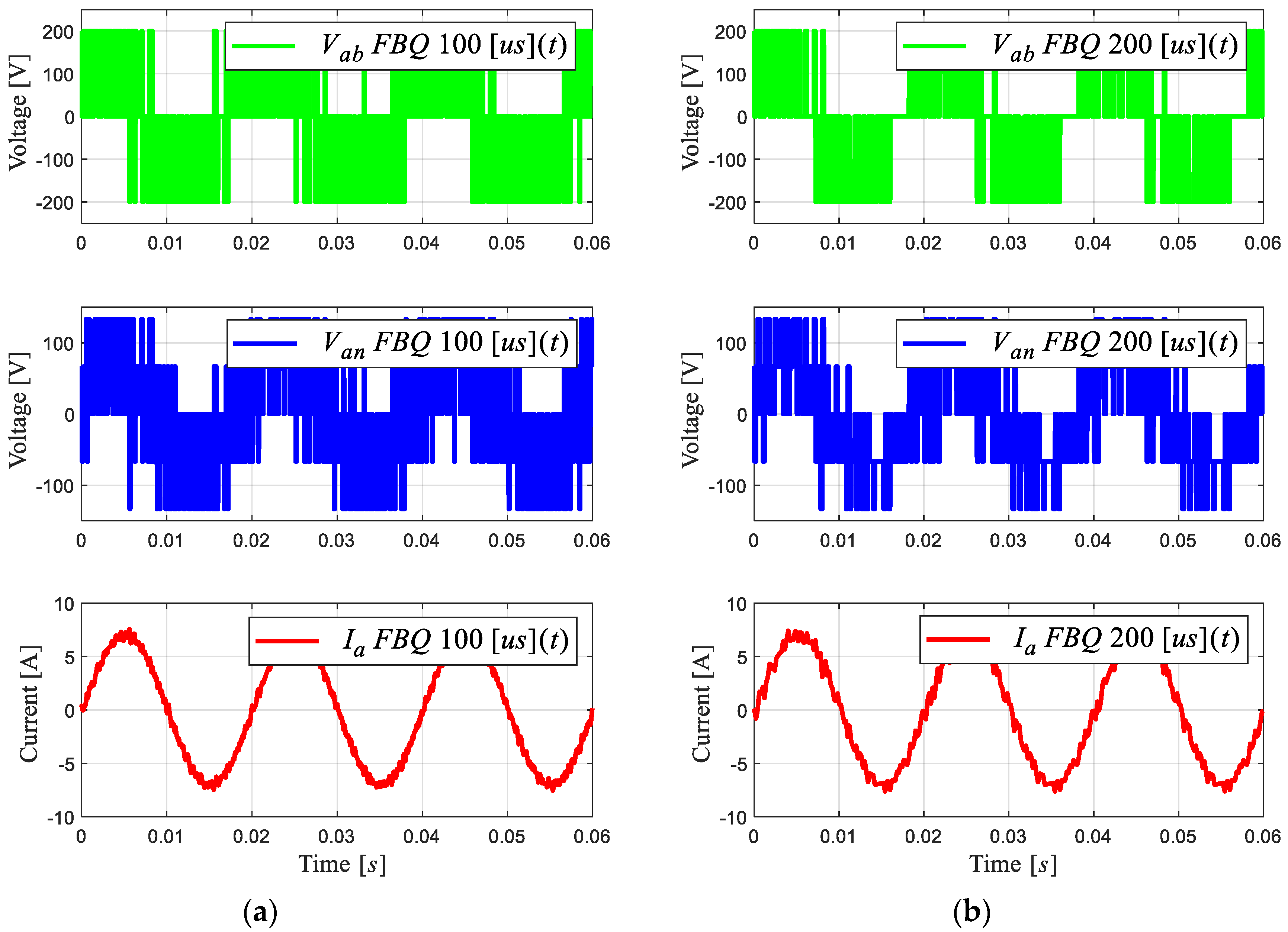
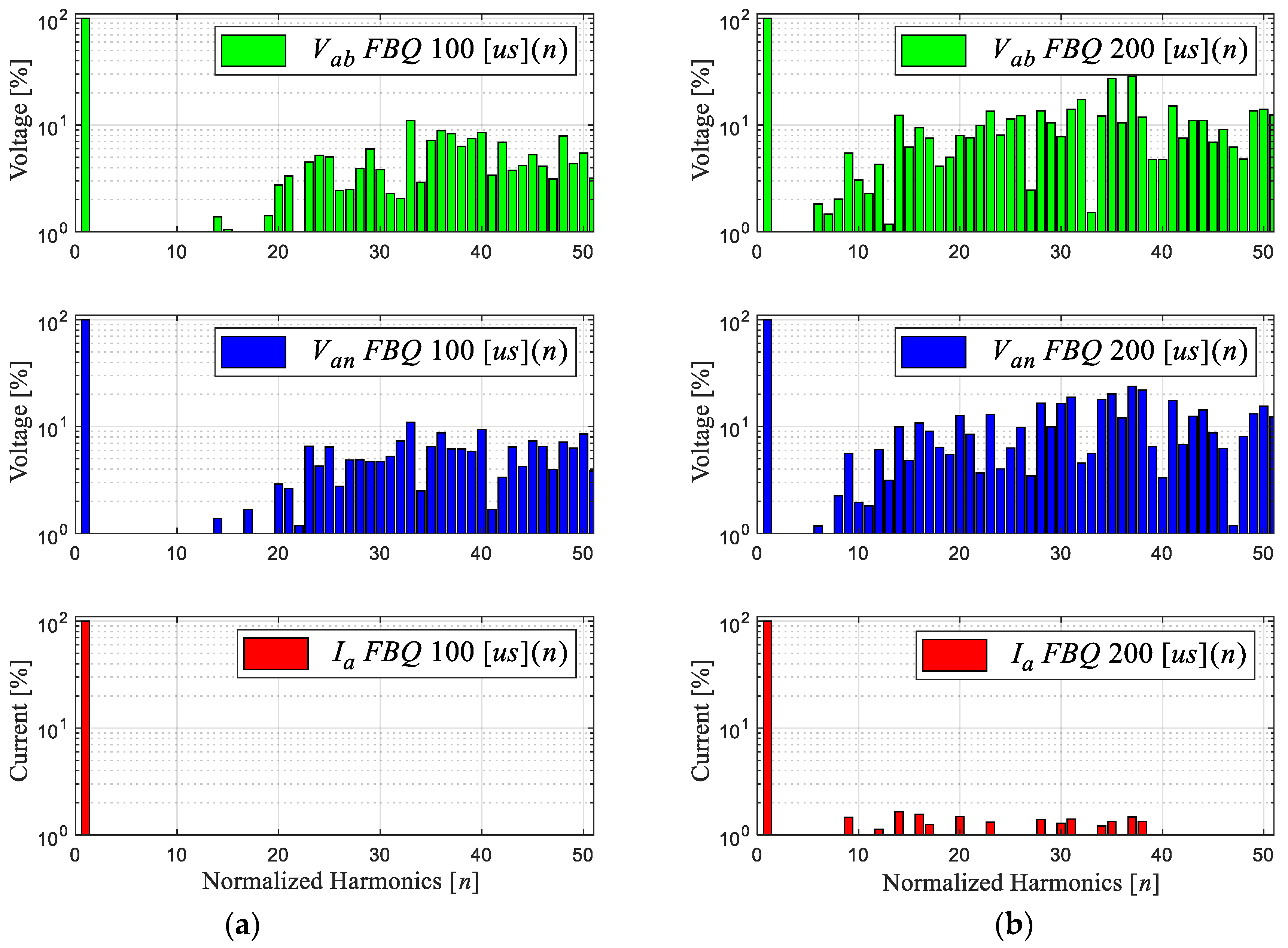
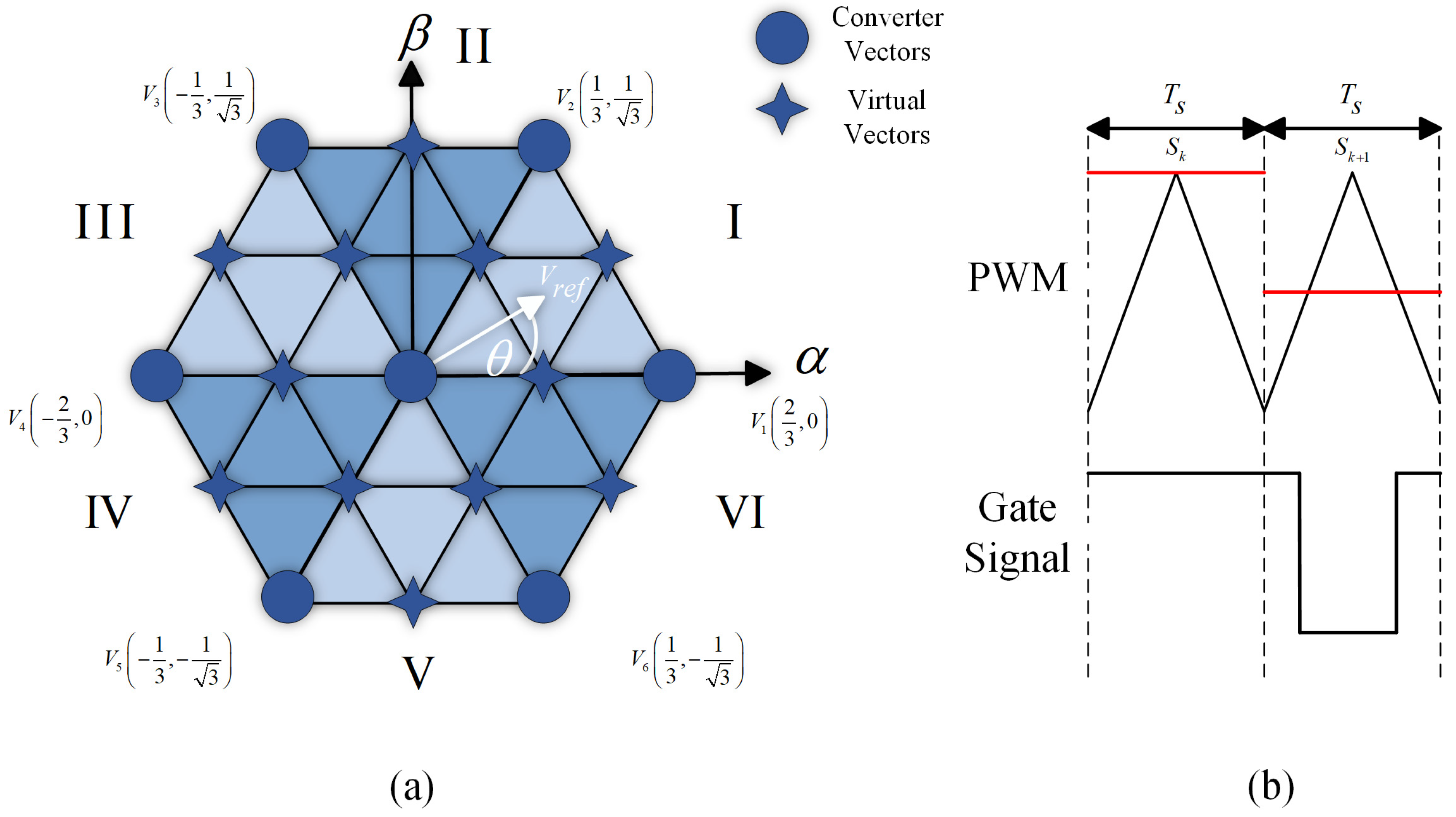
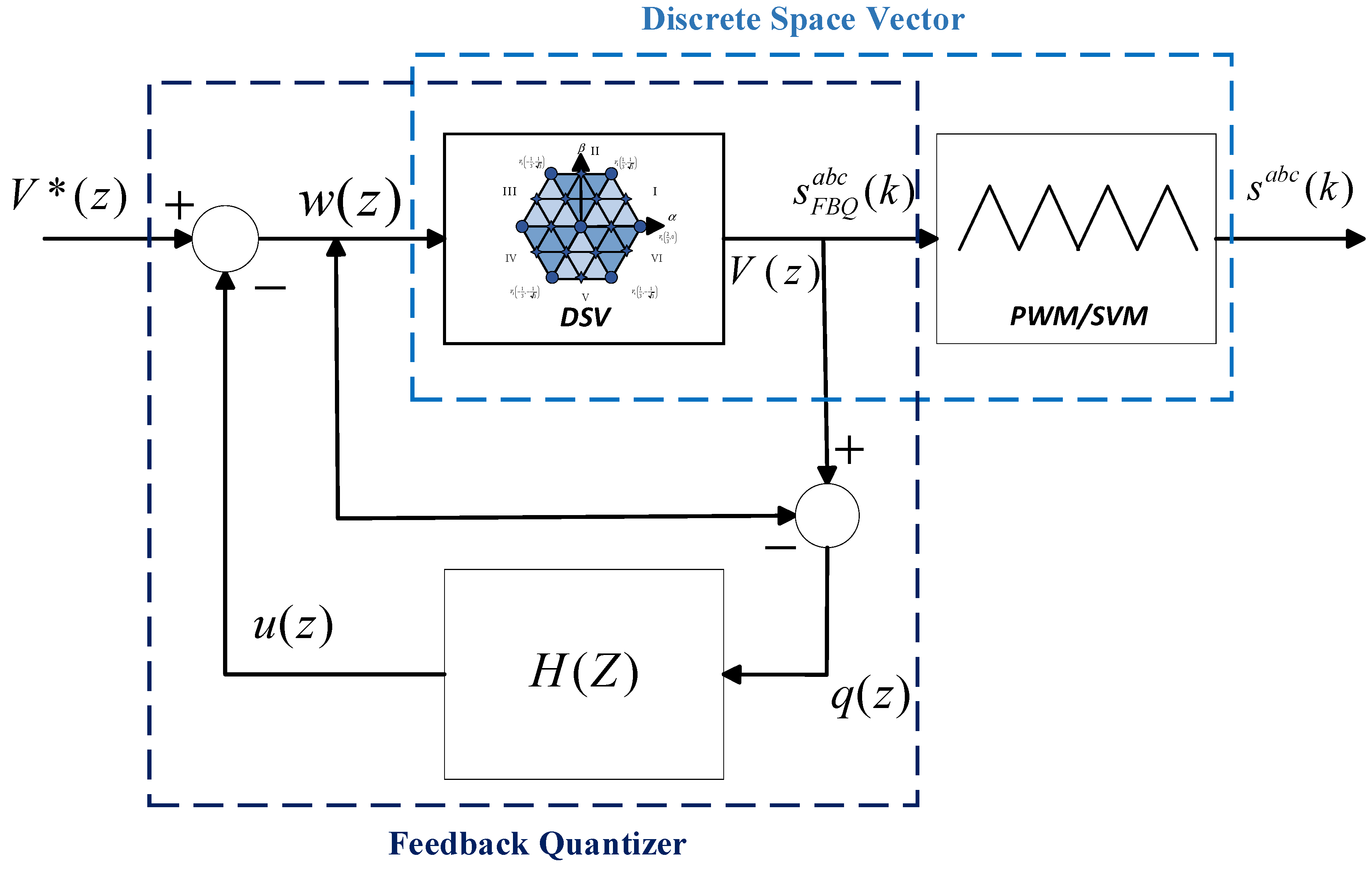
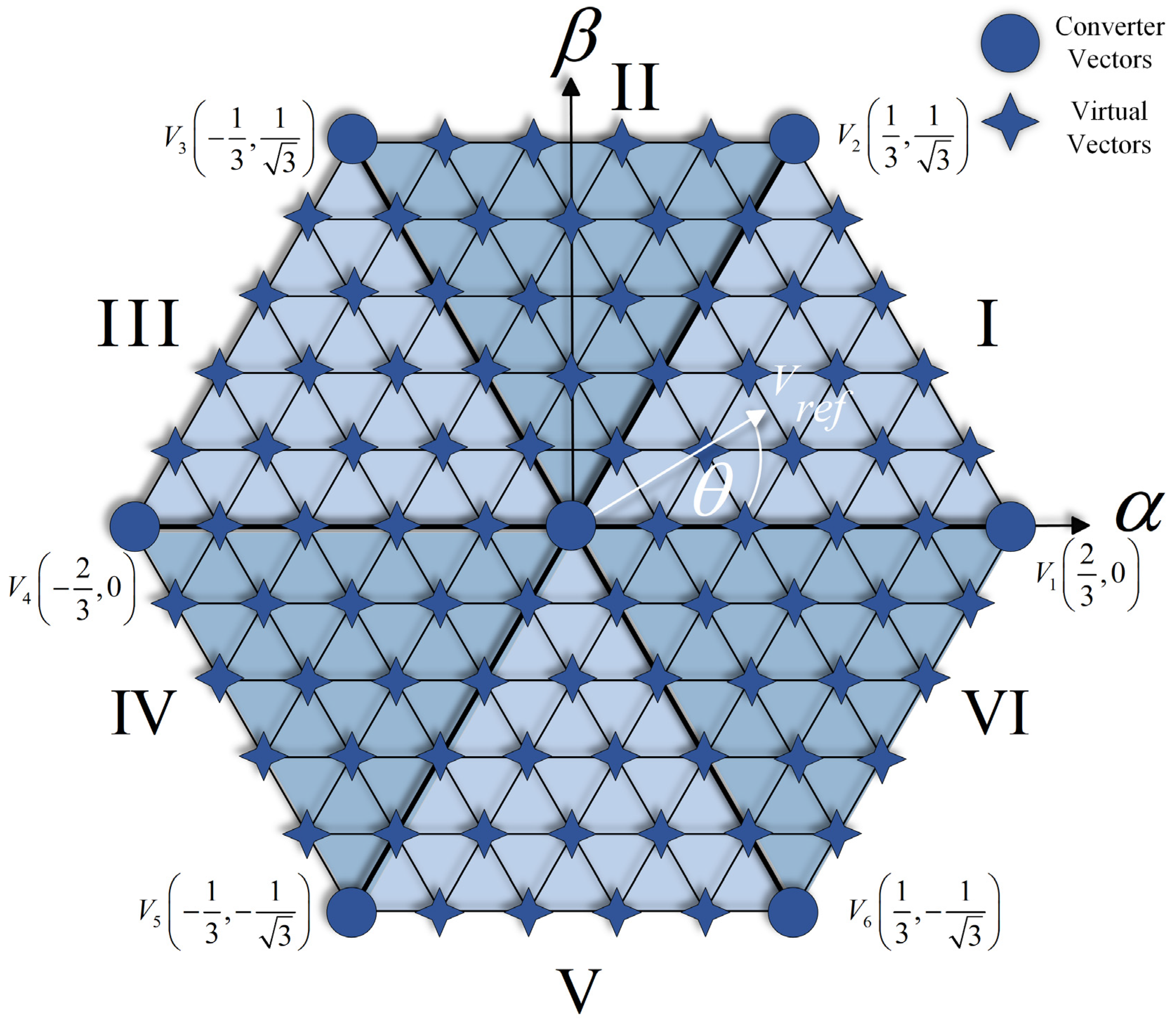
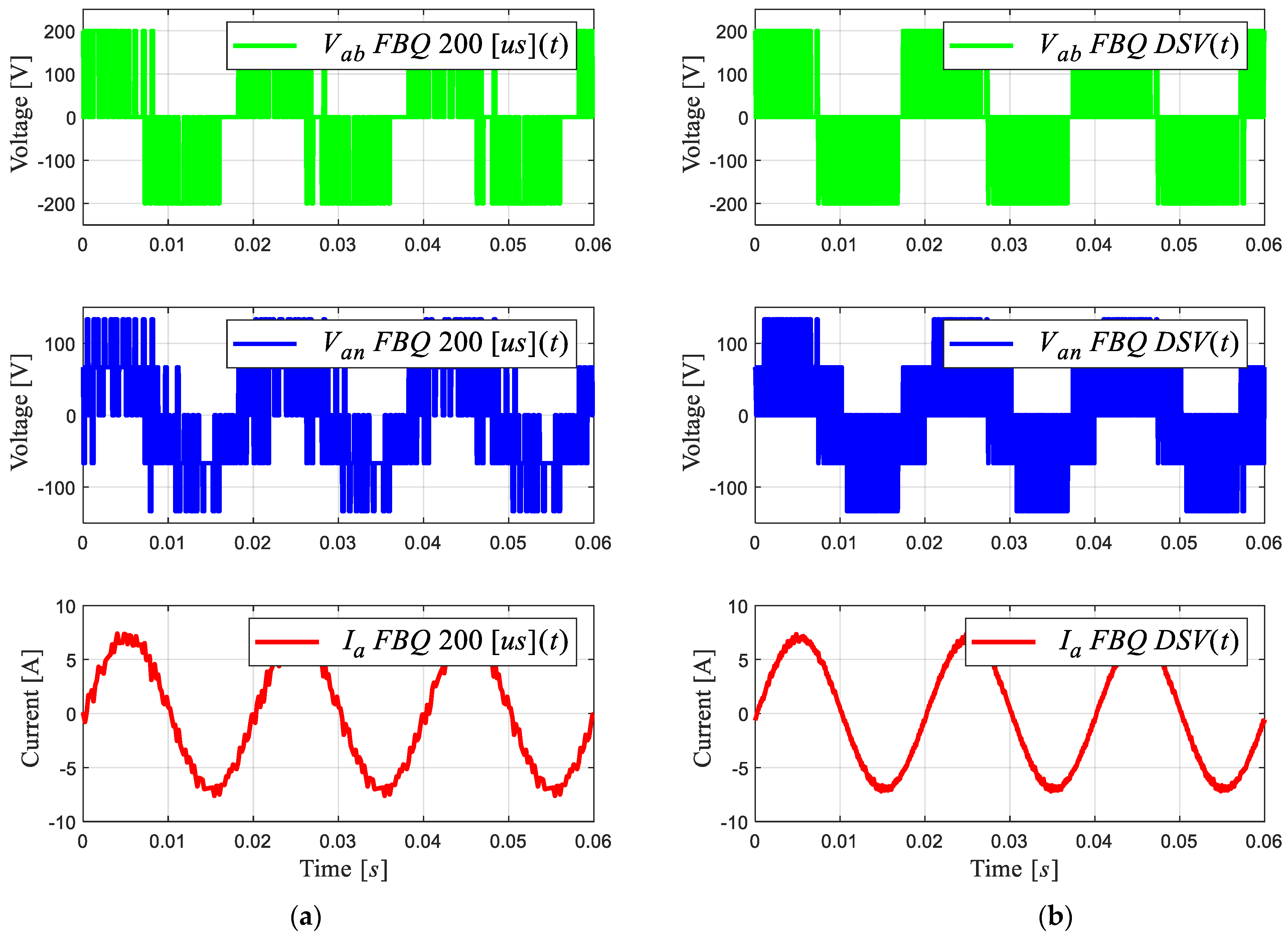
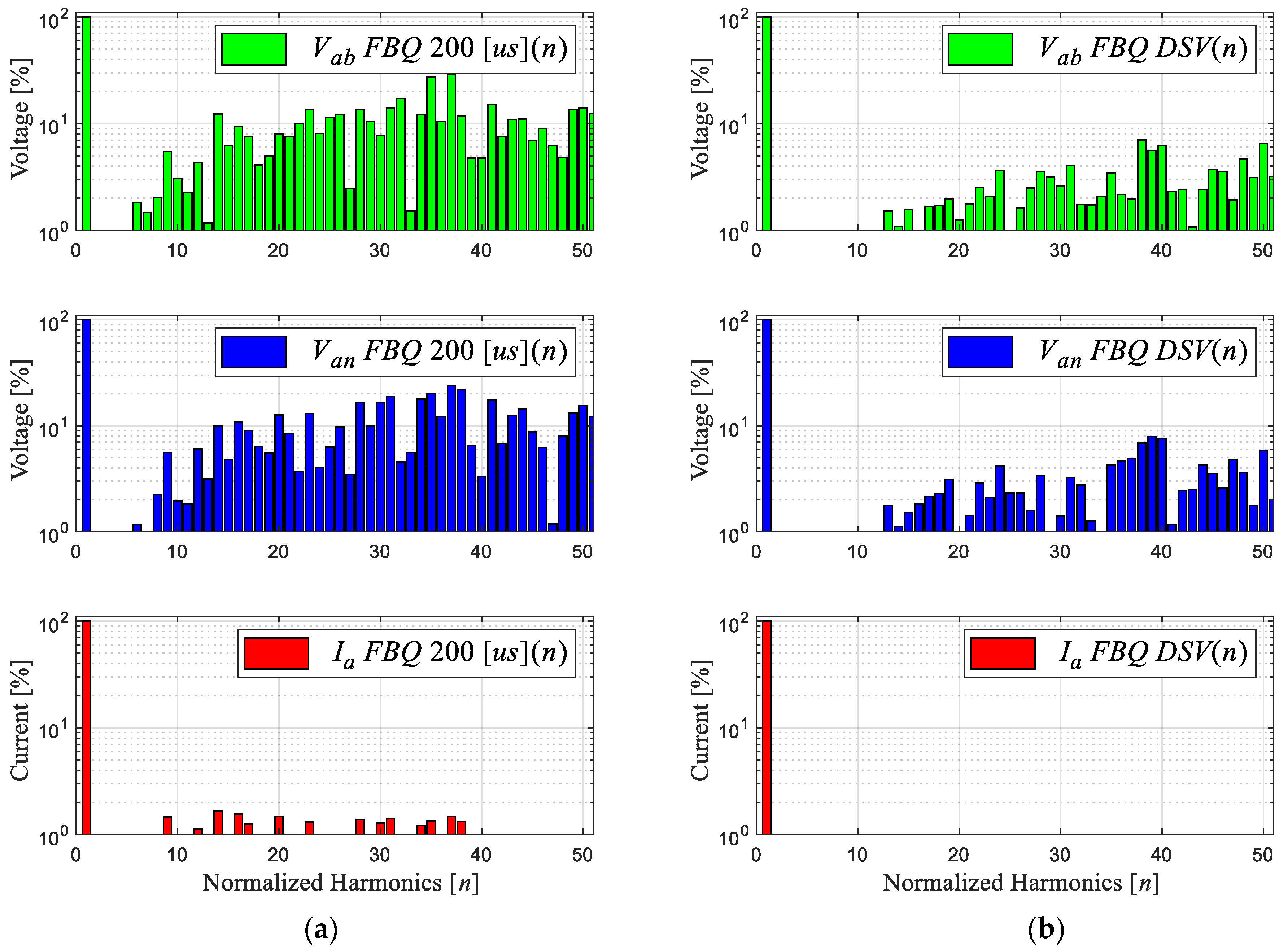

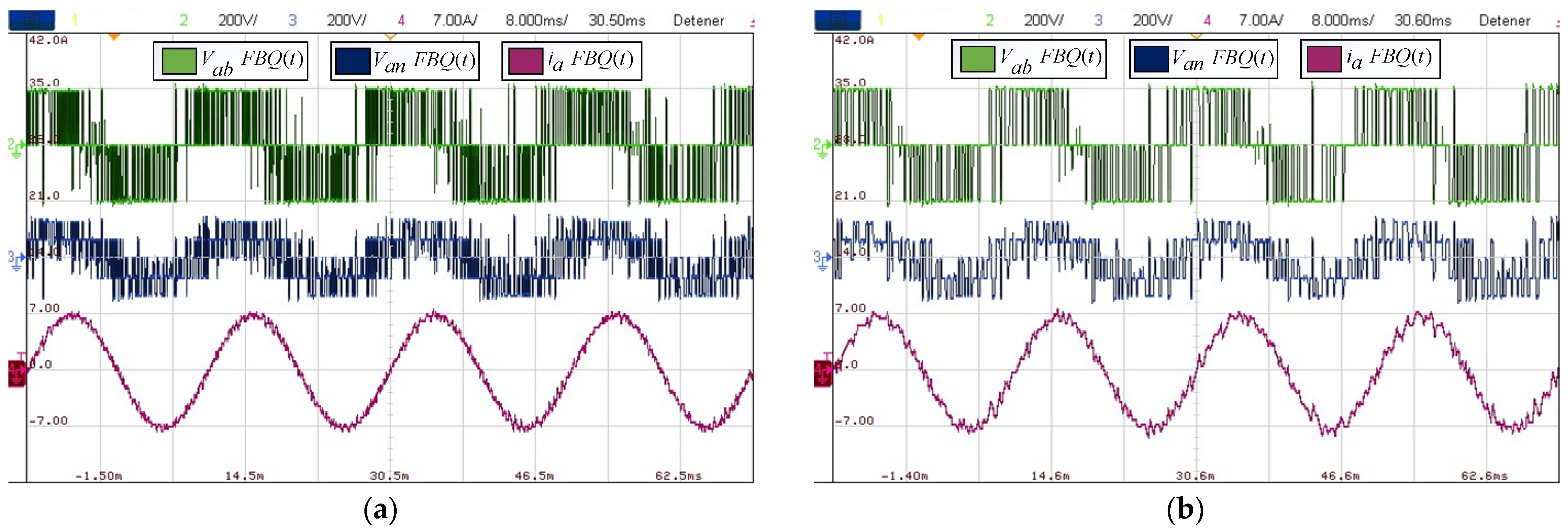
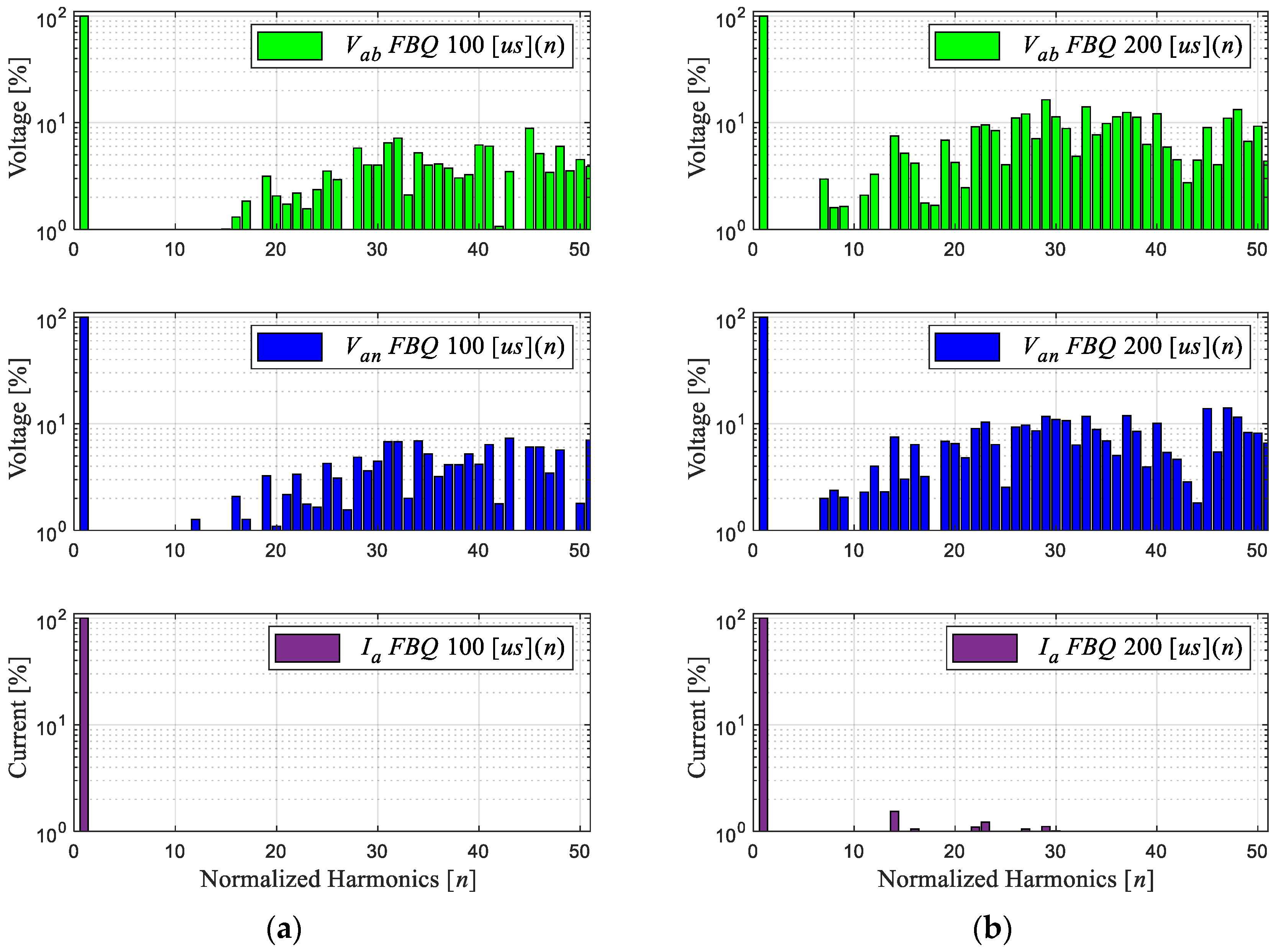



| Vector | a | b | c | ||
|---|---|---|---|---|---|
| 0 | 0 | 0 | 0 | 0 | |
| 1 | 0 | 0 | 2/3 | 0 | |
| 1 | 1 | 0 | 1/3 | ||
| 0 | 1 | 0 | −1/3 | ||
| 0 | 1 | 1 | −2/3 | 0 | |
| 0 | 0 | 1 | −1/3 | ||
| 1 | 0 | 1 | 1/3 | ||
| 1 | 1 | 1 | 0 | 0 |
| Symbol | Name | Value |
|---|---|---|
| Load Resistance | 10 [ | |
| Load Inductance | 15 [mH] | |
| DC Voltage Link | 200 [V] | |
| Sampling Time | 100 [μs]/200 [μs] |
| FBQ 100 [μs] | FBQ 200 [μs] | FBQ 200 [μs] 91 Vectors | |
|---|---|---|---|
| THD Ia [%] | 2.81 | 5.2 | 1.23 |
| THD Va [%] | 39.06 | 45.16 | 16.17 |
| WTHD Ia [%] | 0.083 | 0.30 | 0.0643 |
| WTHD Van [%] | 1.06 | 2.27 | 0.5021 |
| Switching Frequency [Hz] | 2500 | 1200 | 5000 |
| Voltage Reference Tracking [%] | 99.74 | 99.76 | 99.81 |
| FBQ 100 [μs] | FBQ 200 [μs] | FBQ 200 [μs] 91 Vectors | |
|---|---|---|---|
| THD Ia [%] | 2.4822 | 5.0631 | 1.2802 |
| THD Van [%] | 35.6874 | 50.8163 | 11.1990 |
| WTHD Ia [%] | 0.0881 | 0.2874 | 0.1106 |
| WTHD Van [%] | 0.7577 | 1.7429 | 0.4171 |
Disclaimer/Publisher’s Note: The statements, opinions and data contained in all publications are solely those of the individual author(s) and contributor(s) and not of MDPI and/or the editor(s). MDPI and/or the editor(s) disclaim responsibility for any injury to people or property resulting from any ideas, methods, instructions or products referred to in the content. |
© 2024 by the authors. Licensee MDPI, Basel, Switzerland. This article is an open access article distributed under the terms and conditions of the Creative Commons Attribution (CC BY) license (https://creativecommons.org/licenses/by/4.0/).
Share and Cite
Veillon, M.; Espinosa, E.; Melin, P.; Mirzaeva, G.; Rivera, M.; Baier, C.R.; Ramirez, R.O. Improved Feedback Quantizer with Discrete Space Vector. Sensors 2024, 24, 287. https://doi.org/10.3390/s24010287
Veillon M, Espinosa E, Melin P, Mirzaeva G, Rivera M, Baier CR, Ramirez RO. Improved Feedback Quantizer with Discrete Space Vector. Sensors. 2024; 24(1):287. https://doi.org/10.3390/s24010287
Chicago/Turabian StyleVeillon, Matías, Eduardo Espinosa, Pedro Melin, Galina Mirzaeva, Marco Rivera, Carlos R. Baier, and Roberto O. Ramirez. 2024. "Improved Feedback Quantizer with Discrete Space Vector" Sensors 24, no. 1: 287. https://doi.org/10.3390/s24010287
APA StyleVeillon, M., Espinosa, E., Melin, P., Mirzaeva, G., Rivera, M., Baier, C. R., & Ramirez, R. O. (2024). Improved Feedback Quantizer with Discrete Space Vector. Sensors, 24(1), 287. https://doi.org/10.3390/s24010287











